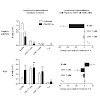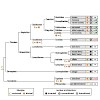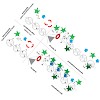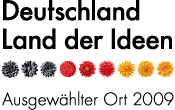Research Area D - Publications 2013
29-Dec-2013
Diabetes, Obesity and Metabolism, online article

Inhibitors of dipeptidylpeptidase IV (DPP-IV) represent a novel class of frequently used anti-diabetic drugs. In addition to its function in metabolic regulation, DPP-IV also plays a role in the immune system. Whether the DPP-IV inhibitors sitagliptin, vildagliptin or saxagliptin impair immune responses is, however, currently unknown. Here, we investigated the ...
12-Dec-2013
Oncotarget, online article

The macrophage migration inhibitory factor (MIF)-homologue D- dopachrome tautomerase (D-DT) recently has been described to have similar functions as MIF. However, the role of D-DT, as opposed to MIF, in tumor biology remains unknown. We hypothesized that D-DT could represent a target for therapeutic interventions in cancer. We analyzed the production of D-DT in ...
05-Dec-2013
Nucleus, online article

Nucleosomes confer a barrier to processes that require access to the eukaryotic genome such as transcription, DNA replication and repair. A variety of ATP-dependent nucleosome remodeling machines and ATP-independent histone chaperones facilitate nucleosome dynamics by depositing or evicting histones and unwrapping the DNA. It is clear that remodeling machines can ...
14-Nov-2013
Developmental Cell, online article

Speciation involves the reproductive isolation of natural populations due to the sterility or lethality of their hybrids. However, the molecular basis of hybrid lethality and the evolutionary driving forces that provoke it remain largely elusive. The hybrid male rescue (Hmr) and the lethal hybrid rescue (Lhr) genes serve as a model to study speciation in ...
25-Oct-2013
Nucleic Acids Research, online article

Epigenetic regulation of gene expression involves, besides DNA and histone modifications, the relative positioning of DNA sequences within the nucleus. To trace specific DNA sequences in living cells, we used programmable sequence-specific DNA binding of designer transcription activator-like effectors (dTALEs). We designed a recombinant dTALE (msTALE) with ...
24-Oct-2013
Nature Communications, 2013, doi:10.1038/ncomms3660, 4, Article number: 2660 published on 24.10.2013
Nature Communications, online article

Protein–protein interactions are the basis of all processes in living cells, but most studies of these interactions rely on biochemical in vitro assays. Here we present a simple and versatile fluorescent-three-hybrid (F3H) strategy to visualize and target protein–protein interactions. A high-affinity nanobody anchors a GFP-fusion protein of interest at a defined ...
18-Oct-2013
Journal of Biological Chemistry, online article

The three tetratricopeptide repeat domain-containing docking proteins Toc64, OM64, and AtTPR7 reside in the chloroplast, mitochondrion, and endoplasmic reticulum of Arabidopsis thaliana, respectively. They are suggested to act during post-translational protein import by association with chaperone-bound preprotein complexes. Here, we performed a detailed ...
11-Oct-2013
EMBO reports, online article

Nucleosome remodelling enzymes of the ISWI family reposition nucleosomes in eukaryotes. ISWI contains an ATPase and a HAND-SANT-SLIDE (HSS) domain. Conformational changes between these domains have been proposed to be critical for nucleosome repositioning by pulling flanking DNA into the nucleosome. We inserted flexible linkers at strategic sites in ISWI to ...
03-Oct-2013
Cell, online article

Chromatin organization and gene activity are responsive to developmental and environmental cues. Although many genes are transcribed throughout development and across cell types, much of gene regulation is highly cell-type specific. To readily track chromatin features at the resolution of cell types within complex tissues, we developed and validated chromatin ...
03-Oct-2013
Nucl. Acids Res., online article

Epstein–Barr virus (EBV) infects and transforms human primary B cells inducing indefinite proliferation. To investigate the potential participation of chromatin mechanisms during the EBV-mediated transformation of resting B cells we performed an analysis of global changes in histone modifications. We observed a remarkable decrease and redistribution of ...
01-Oct-2013
RNA Biology, online article

High concentrations (> 100 µM) of the ribonucleoside analog 4-thiouridine (4sU) is widely used in methods for RNA analysis like photoactivatable-ribonucleoside-enhanced crosslinking and immunoprecipitation (PAR-CLIP) and nascent messenger (m)RNA labeling (4sU-tagging). Here, we show that 4sU-tagging at low concentrations ≤ 10 µM can be used to measure production ...
26-Sep-2013
PLoS Pathogens, online article

The knowledge that many pathogens rely on cell-to-cell communication mechanisms known as quorum sensing, opens a new disease control strategy: quorum quenching. Here we report on one of the rare examples where Gram-positive bacteria, the ‘Staphylococcus intermedius group’ of zoonotic pathogens, excrete two compounds in millimolar concentrations that suppress the ...
05-Sep-2013
Nature Structural & Molecular Biology, online article

Nucleosomes, the basic organizational units of chromatin, package and regulate eukaryotic genomes. ATP-dependent nucleosome-remodeling factors endow chromatin with structural flexibility by promoting assembly or disruption of nucleosomes and the exchange of histone variants. Furthermore, most remodeling factors induce nucleosome movements through sliding of ...
03-Sep-2013
PNAS, 2013, doi: 10.1073/pnas.1310642110, vol. 110 no. 38 15265-15270 published on 03.09.2013
PNAS, online article

Ribosomes are the protein synthesizing factories of the cell, polymerizing polypeptide chains from their constituent amino acids. However, distinct combinations of amino acids, such as polyproline stretches, cannot be efficiently polymerized by ribosomes, leading to translational stalling. The stalled ribosomes are rescued by the translational elongation factor P ...
31-Aug-2013
Chromosome Research, online article

To improve light propagation through the retina, the rod nuclei of nocturnal mammals are uniquely changed compared to the nuclei of other cells. In particular, the main classes of chromatin are segregated in them and form regular concentric shells in order; inverted in comparison to conventional nuclei. A broad study of the epigenetic landscape of the inverted ...
23-Aug-2013
Cell Cycle, online article

The proper regulation and spatial organization of heterochromatin is crucial for a broad range of cellular processes, ranging from gene silencing to maintenance of genomic integrity and cell division. The most prominent heterochromatin domains are formed across repetitive sequences (major satellite repeats) around the centromere regions. Those pericentric ...
16-Aug-2013

The smallest viable unit of life is the cell. From bacteria to mammals, all cells use the same nucleic acid-based universal code for the maintenance and inheritance of genetic information. All life on earth probably started with a common ancestral cell1 approximately 4 billion years ago. Today, a huge diversity of organisms live on Earth, many of them still at ...
01-Aug-2013
Development, online article

Several signalling cascades are implicated in the formation and patterning of the three principal germ layers, but their precise temporal-spatial mode of action in progenitor populations remains undefined. We have used conditional gene deletion of mouse β-catenin in Sox17-positive embryonic and extra-embryonic endoderm as well as vascular endothelial progenitors ...
31-Jul-2013
Trends in Plant Science, online article

Post-translational modifications of the carboxy-terminal domain of the largest subunit of RNA polymerase II (RNAPII CTD) provide recognition marks to coordinate recruitment of numerous nuclear factors controlling transcription, cotranscriptional RNA processing, chromatin remodeling, and RNA export. Compared with the progress in yeast and mammals, deciphering the ...
31-Jul-2013
Landes Bioscience Transcription, online article

The proto-oncogene c-myc encodes a basic helix-loop-helix leucine zipper transcription factor (c-Myc). c-Myc plays a crucial role in cell growth and proliferation. Here, we examined how expression of c-Myc target genes and cell proliferation depend on variation of c-Myc protein levels. We show that proliferation rates, the number of cells in S-phase, and cell ...
25-Jul-2013
Molecular Cell, online article

Dosage compensation in Drosophila involves a global activation of genes on the male X chromosome. The activating complex (MSL-DCC) consists of male-specific-lethal (MSL) proteins and two long, noncoding roX RNAs. The roX RNAs are essential for X-chromosomal targeting, but their contributions to MSL-DCC structure and function are enigmatic. Conceivably, the RNA ...
03-Jul-2013
Blood, online article

Early in the course of infection, detection of pathogen-associated molecular patterns by innate immune receptors can shape the subsequent adaptive immune response. Here we investigate the influence of virus-associated innate immune activation on lymphocyte distribution in secondary lymphoid organs. We show for the first time that virus infection of mice induces ...
13-Jun-2013
PLoS ONE, online article

Beyond their role in post-transcriptional gene silencing, Dicer and Argonaute, two components of the RNA interference (RNAi) machinery, were shown to be involved in epigenetic regulation of centromeric heterochromatin and transcriptional gene silencing. In particular, RNAi mechanisms appear to play a role in repeat induced silencing and some aspects of ...
12-Jun-2013
Genome Res., online article

Transcriptional enhancement of X-linked genes to compensate for the sex chromosome monosomy in Drosophila males is brought about by a ribonucleoprotein assembly called Male-Specific-Lethal or Dosage Compensation Complex (MSL-DCC). This machinery is formed in male flies and specifically associates with active genes on the X chromosome. After assembly at dedicated ...
07-Jun-2013
Science, online article

Evolutionarily young genes that serve essential functions represent a paradox; they must perform a function that either was not required until after their birth or was redundant with another gene. How young genes rapidly acquire essential function is largely unknown. We traced the evolutionary steps by which the Drosophila gene Umbrea acquired an essential role ...
06-Jun-2013
Cell, online article

Drosophila cryptochrome (dCRY) is a FAD-dependent circadian photoreceptor, whereas mammalian cryptochromes (CRY1/2) are integral clock components that repress mCLOCK/mBMAL1-dependent transcription. We report crystal structures of full-length dCRY, a dCRY loop deletion construct, and the photolyase homology region of mouse CRY1 (mCRY1). Our dCRY structures depict ...
06-Jun-2013

Ribosome biogenesis is a process required for cellular growth and proliferation. Processing of ribosomal (r)RNA is highly sensitive to flavopiridol, a specific inhibitor of cyclin-dependent kinase 9 (Cdk9). Cdk9 has been characterised as the catalytic subunit of the positive transcription elongation factor-b (P-TEFb) of RNA polymerase (RNAP)II. Here we studied ...
29-May-2013
Journal of Molecular Cell Biology, online article

Facioscapulohumeral muscular dystrophy (FSHD) is an autosomal dominant myopathy with a strong epigenetic component. It is associated with deletion of a macrosatellite repeat leading to over-expression of the nearby genes. Among them, we focused on FSHD region gene 1 (FRG1) since its over-expression in mice, Xenopus laevis and Caenorhabditis elegans, leads to ...
26-May-2013
The FEBS journal, online article

Poly(ADP-ribosyl)ation is involved in the regulation of a variety of cellular pathways, including, but not limited to, transcription, chromatin, DNA damage and other stress signalling. Similar to other tightly regulated post-translational modifications, poly(ADP-ribosyl)ation employs ‘writers’, ‘readers’ and ‘erasers’ to confer regulatory functions. The ...
25-May-2013
Evolutionary Biology, online article

Diurnality, associated with enhanced visual acuity and color vision, is typical of most modern Primates. However, it remains a matter of debate when and how many times primates re-acquired diurnality or returned to nocturnality. We analyzed the features specific to nocturnal and diurnal vision that were recently found in the nuclei of mammalian rod photoreceptor ...
22-May-2013

Facilitates chromatin transcription (FACT) is a conserved histone chaperone that reorganizes nucleosomes and ensures chromatin integrity during DNA transcription, replication and repair. Key to the broad functions of FACT is its recognition of histones H2A–H2B (ref. 2). However, the structural basis for how histones H2A–H2B are recognized and how this integrates ...
21-May-2013
Mary Ann Liebert, Inc. publishers, online article

Here we report that chromatin, the complex and dynamic eukaryotic DNA packaging structure, is able to sense cellular redox changes. Histone H3, the only nucleosomal protein that possesses cysteine(s), can be modified by glutathione (GSH).
13-May-2013
EMBO Molecular Medicine, online article

Pigment cells and neuronal cells both are derived from the neural crest. Here, we describe the Pit-Oct-Unc (POU) domain transcription factor Brn3a, normally involved in neuronal development, to be frequently expressed in melanoma, but not in melanocytes and nevi. RNAi-mediated silencing of Brn3a strongly reduced the viability of melanoma cell lines and decreased ...
01-May-2013

The production and processing of ribosomal RNA is a complex and well-coordinated nucleolar process for ribosome biogenesis. Progress in understanding nucleolar structure and function has lead to the unexpected discovery of the nucleolus as highly sensitive sensor of cellular stress and important regulator of the tumour suppressor p53. Inhibition of ribosomal RNA ...
28-Apr-2013
Nature Cell Biology, online article

Cdc48 (also known as p97), a conserved chaperone-like ATPase, plays a strategic role in the ubiquitin system1, 2, 3. Empowered by ATP-driven conformational changes 4, Cdc48 acts as a segregase by dislodging ubiquitylated proteins from their environment1, 2, 5. Ufd1, a known co-factor of Cdc48, also binds SUMO (ref. 6), but whether SUMOylated proteins are subject ...
19-Apr-2013
Science, online article

Conrad et al. (Reports, 10 August 2012, p. 742) reported that Drosophila dosage compensation might largely be due to increased recruitment of RNA polymerase II to promoters. A reassessment of the numerical operations revealed that the authors’ calculations are severely confounded by an inappropriate numerical procedure. A rectified analysis strongly suggests that ...
18-Apr-2013
Genes & Dev., online article

Cohesin plays an important role in chromatid cohesion and has additional functions in higher-order chromatin organization and in transcriptional regulation. The binding of cohesin to euchromatic regions is largely mediated by CTCF or the mediator complex. However, it is currently unknown how cohesin is recruited to pericentric heterochromatin in mammalian cells. ...
17-Apr-2013
Genes & Dev., online article

Transcription steps are marked by different modifications of the C-terminal domain of RNA polymerase II (RNAPII). Phosphorylation of Ser5 and Ser7 by cyclin-dependent kinase 7 (CDK7) as part of TFIIH marks initiation, whereas phosphorylation of Ser2 by CDK9 marks elongation. These processes are thought to take place in localized transcription foci in the nucleus, ...
15-Apr-2013
The Journal of Immunology, online article

The trafficking of effector T cells is tightly regulated by the expression of site-specific sets of homing molecules. In contrast, naive T cells are generally assumed to express a uniform pattern of homing molecules and to follow a random distribution within the blood and secondary lymphoid organs. In this study, we demonstrate that systemic infection ...
04-Apr-2013

Histone variants play important roles in eukaryotic genome organization, the control of gene expression, cell division and DNA repair. Unlike other organisms that employ several H2A variants for different functions, the parsimonious fruit fly Drosophila melanogaster gets along with just a single H2A variant, H2A.V. Remarkably, H2A.V unites within one molecule ...
27-Mar-2013

DNA methyltransferase 1 (Dnmt1) reestablishes methylation of hemimethylated CpG sites generated during DNA replication in mammalian cells. Two subdomains, the proliferating cell nuclear antigen (PCNA)-binding domain (PBD) and the targeting sequence (TS) domain, target Dnmt1 to the replication sites in S phase. We aimed to dissect the details of the cell ...
Deficiency of terminal ADP-ribose protein glycohydrolase TARG1/C6orf130 in neurodegenerative disease
12-Mar-2013
The EMBO Journal, online article

Adenosine diphosphate (ADP)-ribosylation is a post-translational protein modification implicated in the regulation of a range of cellular processes. A family of proteins that catalyse ADP-ribosylation reactions are the poly(ADP-ribose) (PAR) polymerases (PARPs). PARPs covalently attach an ADP-ribose nucleotide to target proteins and some PARP family members can ...
10-Mar-2013
Nature Structural & Molecular Biology, online article

ADP-ribosylation is a reversible post-translational modification with wide-ranging biological functions in all kingdoms of life. A variety of enzymes use NAD+ to transfer either single or multiple ADP-ribose (ADPr) moieties onto distinct amino acid substrates, often in response to DNA damage or other stresses. Poly-ADPr-glycohydrolase readily reverses ...
05-Mar-2013
CELL Structure, online article

ADP-ribosyltransferases (ARTs) catalyze the transfer of ADP-ribose from NAD+ onto substrates. Some ARTs generate in an iterative process ADP-ribose polymers that serve as adaptors for distinct protein domains. Other ARTs, exemplified by ARTD10, function as mono-ADP-ribosyltransferases, but it has been unclear whether this modification occurs in cells and how it ...
22-Feb-2013
PLOS, online article

Histone lysine (K) methylation has been shown to play a fundamental role in modulating chromatin architecture and regulation of gene expression. Here we report on the identification of histone H3K56, located at the pivotal, nucleosome DNA entry/exit point, as a novel methylation site that is evolutionary conserved. We identify trimethylation of H3K56 (H3K56me3) ...
21-Feb-2013

Tet proteins oxidize 5-methylcytosine (mC) to generate 5-hydroxymethyl (hmC), 5-formyl (fC), and 5-carboxylcytosine (caC). The exact function of these oxidative cytosine bases remains elusive. We applied quantitative mass-spectrometry-based proteomics to identify readers for mC and hmC in mouse embryonic stem cells (mESC), neuronal progenitor cells (NPC), and ...
31-Jan-2013
Cell, online article

Eukaryotic cells have a layer of heterochromatin at the nuclear periphery. To investigate mechanisms regulating chromatin distribution, we analyzed heterochromatin organization in different tissues and species, including mice with mutations in the lamin B receptor (Lbr) and lamin A (Lmna) genes that encode nuclear envelope (NE) proteins. We identified LBR- and ...
23-Jan-2013
Nucl. Acids Res., 2013, doi: 10.1093/nar/gkt012, 41 (5): 2797-2806. published on 23.01.2013
Nucl. Acids Res., online article

Maintenance of genomic integrity is essential to ensure normal organismal development and to prevent diseases such as cancer. Nuclear DNA is packaged into chromatin, and thus genome maintenance can be influenced by distinct chromatin environments. In particular, post-translational modifications of histones have emerged as key regulators of genomic integrity. ...
22-Jan-2013

The circadian clock is constituted by a complex molecular network that integrates a number of regulatory cues needed to maintain organismal homeostasis. To this effect, posttranslational modifications of clock proteins modulate circadian rhythms and are thought to convert physiological signals into changes in protein regulatory function. To explore reversible ...
21-Jan-2013
Cancer Research, online article

Deregulated TGF-β signaling in pancreatic cancer promotes tumor growth, invasion, metastasis, and a potent immunosuppressive network. A strategy for disrupting this tumor-promoting pathway is silencing TGF-β by siRNA. By introducing a triphosphate group at the 5′ end of siRNA (ppp-siRNA), gene silencing can be combined with immune activation via the cytosolic ...
15-Jan-2013
PLOS Genetics, online article

Post-translational modifications (PTMs) of histones exert fundamental roles in regulating gene expression. During development, groups of PTMs are constrained by unknown mechanisms into combinatorial patterns, which facilitate transitions from uncommitted embryonic cells into differentiated somatic cell lineages. Repressive histone modifications such as H3K9me3 or ...
08-Jan-2013
The EMBO Journal, online article

Gene silencing in budding yeast relies on the binding of the Silent Information Regulator (Sir) complex to chromatin, which is mediated by extensive interactions between the Sir proteins and nucleosomes. Sir3, a divergent member of the AAA+ ATPase-like family, contacts both the histone H4 tail and the nucleosome core. Here, we present the structure and function ...










